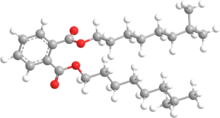Chemistry:Diisononyl phthalate

| |

| |
| Names | |
|---|---|
| Preferred IUPAC name
1,2-Benzenedicarboxylic acid, di-C8-10 branched alkyl esters, C9 rich | |
| Other names
1,2-Benzenedicarboxylic acid, 1,2-diisononyl ester
| |
| Identifiers | |
3D model (JSmol)
|
|
| Abbreviations | DINP |
| ChEBI | |
| ChemSpider | |
PubChem CID
|
|
| UNII | |
| |
| |
| Properties | |
| C26H42O4 | |
| Molar mass | 418.618 g·mol−1 |
| Appearance | Oily viscous liquid |
| Density | 0.98 g/cm3 |
| Melting point | −43 °C (−45 °F; 230 K) |
| Boiling point | 244 to 252 °C (471 to 486 °F; 517 to 525 K) at 0.7 kPa |
| <0.01 g/mL at 20 °C | |
| Viscosity | 64 to 265 mPa·s |
| Hazards | |
| Flash point | 221 °C (430 °F; 494 K) (c.c.) |
| 380 °C (716 °F; 653 K) | |
Except where otherwise noted, data are given for materials in their standard state (at 25 °C [77 °F], 100 kPa). | |
| Infobox references | |
Diisononyl phthalate (DINP) is a phthalate used as a plasticizer. DINP is typically a mixture of chemical compounds consisting of various isononyl esters of phthalic acid, and is commonly used in a large variety of plastic items.
Health Issues
The European Union has set a maximum specific migration limit (SML) from food contact materials of 9 mg/kg food for the sum of diisononyl phthalates and diisodecyl phthalates.[2]
DINP is listed as a substance "known to the State of California to cause cancer" under Proposition 65 legislation.[3]
Studies find that exposure to environmentally relevant concentrations of DINP in zebrafish disrupt the endocannabinoid system (ECS) and affect reproduction in a gender specific manner,[4] and have other adverse effects on aquatic organisms, as DINP upregulates orexigenic signals and causes hepatosteatosis together with deregulation of the peripheral ECS and lipid metabolism.[5]
ECHA's Risk Assessment Committee (RAC) has concluded, on March 7, 2018, that Di-isononyl phthalate (DINP) does not warrant classification for reprotoxic effects under the EU's Classification, Labelling and Packaging (CLP) regulation [6]
See also
- Diisoheptyl phthalate
- Plastic pollution
References
- ↑ Diisononyl phthalate at Inchem.org
- ↑ "EU legislative list for food contact materials". http://ec.europa.eu/food/food/chemicalsafety/foodcontact/legisl_list_en.htm.
- ↑ "State of California, Chemicals known to the state to cause cancer or reproductive toxicity, January 3, 2014". Archived from the original on 2014-01-10. https://web.archive.org/web/20140110153001/http://oehha.ca.gov/prop65/prop65_list/files/P65single01032014.pdf.
- ↑ Forner-Piquer, Isabel; Santangeli, Stefania; Maradonna, Francesca; Rabbito, Alessandro; Piscitelli, Fabiana; Habibi, Hamid R.; Di Marzo, Vincenzo; Carnevali, Oliana (2018-10-01). "Disruption of the gonadal endocannabinoid system in zebrafish exposed to diisononyl phthalate" (in en). Environmental Pollution 241: 1–8. doi:10.1016/j.envpol.2018.05.007. ISSN 0269-7491. PMID 29793103.
- ↑ Forner-Piquer, Isabel; Maradonna, Francesca; Gioacchini, Giorgia; Santangeli, Stefania; Allarà, Marco; Piscitelli, Fabiana; Habibi, Hamid R; Di Marzo, Vincenzo et al. (2017-08-14). "Dose-Specific Effects of Di-Isononyl Phthalate on the Endocannabinoid System and on Liver of Female Zebrafish" (in en). Endocrinology 158 (10): 3462–3476. doi:10.1210/en.2017-00458. ISSN 0013-7227. PMID 28938452.
- ↑ "Evaluation of new scientific evidence concerning DINP and DIDP". https://echa.europa.eu/documents/10162/31b4067e-de40-4044-93e8-9c9ff1960715.
 |
